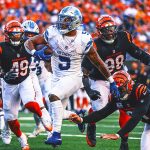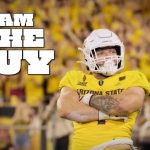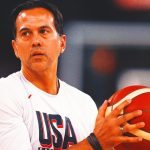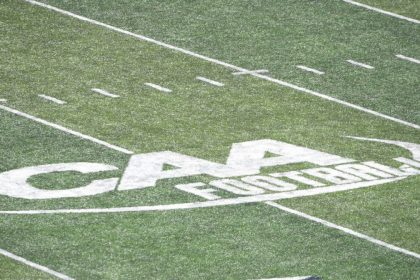Editor’s note: This is part of an ongoing series on how college coaches fare at developing players for the NFL. Check out previous stories on SEC offensive players, SEC defensive players, ACC offensive players, ACC defensive players, Big 12 defensive players, Big 12 offensive players, Pac-12 offensive players, Pac-12 defensive players, Big Ten offensive players, Big Ten defensive players.
Following the 2023 NFL Draft, FOX Sports pulled decades worth of recruiting data and looked at how productive (or not) each active Power 5 coach was at both recruiting and developing players when it came to the ultimate eye in the sky of the NFL.
Across nearly a dozen parts this summer, we’ve looked at every Power 5 league to see who the best coaches within each conference are at developing players across every position group. But when looking at the picture nationally, just how do coaches stack up against each other when it comes to finding all of those good players and, well, coaching them up?
To sort it all out, FOX Sports utilized a points system that rewarded development and applied it to every active Power 5 coach’s draft class. Every drafted wide receiver and tight end received a certain number based on what round he was drafted and what kind of recruit he was coming out of high school. An unrated wide receiver or tight end coming out of high school going in the first round would be at the very highest end of the scale, while a former five-star sneaking into the seventh round of the draft would be at the lowest end.
ADVERTISEMENT
To get a better picture of just how effective coaches were, this cumulative score was then divided by the number of seasons coached at the Division I level to get an overall rating.
As a result, here’s a look at how every active Power 5 coach in the country does when it comes to producing wide receivers and tight ends for the next level:
The Best (WR): Ryan Day (Ohio State)
As one of the best at developing NFL quarterbacks, it only makes sense that Day is equally high among coaches when it comes to the guys on the other end of all those passes.
Still, it’s a much starker separation from others at this particular position for the Buckeyes head coach. While some of the credit undoubtedly goes to former NFL receiver/position coach/offensive coordinator Brian Hartline, OSU has had three first-round receivers in Day’s four full seasons as head coach. During that same time span, all but one of the six wideouts drafted have gone in the first 100 picks and the median selection of No. 40 in the draft falls just outside the first round.
The scariest thing: The best wide receiver to play for Day is not going to be drafted until next year when Marvin Harrison Jr. hears his name called (likely in the first five picks). Based on the current crop of receivers in Columbus, he won’t be the only one either.
So while Nick Saban might have the overall totals to blow everybody out of the water, and other title-winning coaches like Dabo Swinney and Kirby Smart are still setting a high bar, nobody can compare to what Day has been able to do in terms of quality and quantity in such a short time frame as head coach.

The Best (TE): Chip Kelly (UCLA)
Kelly is unlikely to be the first name on many people’s mind when it comes to the tight end position, but the soon-to-be Big Ten coach has sent five to the NFL in nine seasons – averaging a top-100 pick at the position roughly every three years. This dates back to his time at Oregon where Ed Dickson became a star while catching passes in Kelly’s uptempo system.
In Westwood, Kelly has thrived with tight ends who pick apart defenses in the middle of the field. Caleb Wilson was actually a two-star QB coming out of high school but walked on across town before winding up as a seventh-rounder after a stint with the Bruins. Greg Dulcich began his football-playing life as a walk-on as well before the Denver Broncos snagged him in the third round.

Also excellent (WR): Josh Heupel (Tennessee), Lincoln Riley (USC), Mel Tucker (Michigan State), Nick Saban (Alabama), Sonny Dykes (TCU), Dabo Swinney (Clemson), Dana Holgorsen (Houston)
It’s hardly unexpected that coaches running the Air Raid tend to over index when it comes to producing quality receivers.
Tennessee’s Josh Heupel is averaging one receiver drafted per season, and half of them have been taken inside the first 100 picks. Development has also been key in addition to catching a lot of passes, with the head coach turning a walk-on soccer player in Jacob Harris into a fourth-round pick and two-star Cedric Tillman into a top-75 selection.
In the newly-constructed Big 12, Sonny Dykes is the only member of the league (and one of just four active coaches) to have at least 10 receivers drafted over the course of their careers. Half of his double-digit haul have also been transfers, and he’s had multiple receivers drafted at TCU, SMU and Cal. The only time he hasn’t, interestingly enough, was in his first gig at Louisiana Tech where Dykes turned junior college transfer Quinton Patton into an All-WAC selection before going in the fourth round.
Holgorsen, also a Mike Leach protégé and former receiver in college, has had plenty of success across his tenures at West Virginia and Houston. This past spring, ex-two-star Tank Dell wound up as the No. 69 pick for the Texans and half of Holgorsen’s eight total NFL receivers have likewise gone in the top 100. The head coach is also one of eight current coaches who have had multiple first-round picks at the position.
One of the other eight is Riley, who is far and away the best in the Pac-12 and not too far off of Day’s production. Riley has seen four wideouts selected in six seasons with a median selection inside the first round at No. 24 overall.
None of the aforementioned names, however, hold a candle to Saban when it comes to cumulative totals and amount of impact players. While there are just four active coaches to even hit triple-digits in receivers drafted, the Tide’s coach has done that with the number of first-round picks at the position alone. Every five-star receiver he’s recruited to Tuscaloosa has wound up a first rounder, and 90% of all wideouts he’s coached have been taken inside the top 100. Saban produced first-rounders at LSU and Michigan State before that too.
If it were not for his 27 years as a head coach, bringing his overall score down slightly, there would be an easy answer to top this list. Not bad – or perhaps appropriate – for a guy whose specialty before he got a top job was coaching the defensive backs that guard wideouts.

Also excellent (TE): Kirk Ferentz (Iowa), Kirby Smart (Georgia), Shane Beamer (South Carolina), Brian Kelly (LSU), Jeff Hafley (Boston College), Bret Bielema (Illinois)
Ferentz likely would be the first name on people’s minds when it comes to tight end given that he’s the only active coach to reach double-figures (he has 12) at the position. This includes being the only active coach with multiple first-round TE’ and half of his players who catch passes with a hand in the dirt winding up as top-100 picks.
Success stories like walk-on Dallas Clark winding up in the first round, plus three-stars like George Kittle (fifth round), Sam LaPorta (second) and T.J. Hockenson (first) all going early in the draft, further help the case. Though Kelly is a bit more productive, there’s nobody better overall when it comes to total production than the dean of FBS head coaches.
That said, Smart is hot on both of their tails and should add to his track record next spring when Brock Bowers winds up going in the first round. Until then, the Bulldogs coach will settle for five tight ends drafted in seven seasons. Kelly, who Smart and the Bulldogs went up against in the SEC title game this past season, isn’t too shabby either, having the second most NFL picks at TE of any coach (nine) and more than half of them (five) going in the top 100.
Bielema is excellent as well with six tight ends drafted across stints at Arkansas and Wisconsin, and nearly a third of players recruited as tight ends ending up in the league as draft picks too.

Others of note (WR): Kirby Smart (Georgia), Jeff Brohm (Louisville), James Franklin (Penn State), Hugh Freeze (Auburn), Jeff Hafley (Boston College), Lane Kiffin (Ole Miss), P.J. Fleck (Minnesota)
Given the way he’s recruiting the past few cycles, there’s probably not going to be a position that Smart is sub-par in developing, but his rise up the ranks is notable – especially for someone who is a defensive-minded head coach first and foremost. The Georgia alum has particularly had success with speedsters capable of taking the top off opponents, successfully sending former five-stars like George Pickens and Mecole Hardman to become second rounders. Javon Wims is the only wideout Smart has had drafted that was ranked below four-stars coming out of high school, but the junior college transfer did earn that type of ranking before making it to Athens.
Kiffin has also found a sweet spot developing second rounders with top-tier athleticism, having coached a pair of them at both USC and Ole Miss among his six wideouts drafted.
Brohm is another head coach who has done well with receivers across multiple stops. Stretching back to his Western Kentucky days, Brohm turned two-star Taywan Taylor into a third round and top-100 pick while having at least one receiver taken in the past three drafts following his stint at Purdue. Two of the three wide receivers Brohm has had drafted went in the first 100 picks, with the lone exception being Charlie Jones, a two-star out of high school who transferred twice before starring with the Boilermakers and winding up as a fourth-round selection.
In the Big Ten Conference, Fleck knows the in’s and out’s of the position well having coached receivers in the NFL. While at Western Michigan, Corey Davis went from overlooked two-star to FBS’ all-time career leader in receiving yards and a top-five pick in 2017. Half of the four-stars or higher Fleck has recruited at Minnesota have wound up being drafted (such as first-rounder Rashod Bateman).

Others of note (TE): James Franklin (Penn State), Jeff Brohm (Louisville), Lane Kiffin (Ole Miss), Ryan Day (Ohio State)
Franklin has seen three of his four tight ends taken in the first 100 picks. Day hasn’t matched that production, but a third- and fifth-rounder at tight end in just five seasons as head coach, four full-time, is a strong start.
Brohm, who is far and away the best in the ACC now that he’s joined the league, has also seen three tight ends drafted across nine seasons in the big chair (none ranked higher than three-stars coming out of high school). Given his likely increased recruiting abilities at his native Louisville and the type of offense he runs, Brohm could continue to put some distance on some of his other peers when it comes to overall figures.
Surprisingly disappointing (WR): Kyle Whittingham (Utah), Steve Sarkisian (Texas), Kirk Ferentz (Iowa), Dave Clawson (Wake Forest), Dave Doeren (NC State), Chris Klieman (Kansas State), Dino Babers (Syracuse)
Having long tenures with few receivers produced is going to impact how you’re viewed in terms of developing players, and that’s underscored by many of the names above. Whittingham, who is below average at most offensive skill positions, has had just one receiver drafted since Utah joined the Pac-12 and has seen only three in total.
Sarkisian, though he has a first-rounder to his credit, has only had one wideout drafted across the nine years and three stops he’s been a head coach. While that is likely to change with some more time in Austin, the reputation as an OC/play-caller for receivers is a little different from the reality.
Surprisingly disappointing (TE): Chris Klieman (Kansas State), Scott Satterfield (Cincinnati), Dave Doeren (N.C. State), Dave Clawson (Wake Forest), Pat Narduzzi (Pitt), Dino Babers (Syracuse), Mark Stoops (Kentucky)
Klieman and Babers are the only two head coaches with nearly a decade in charge who haven’t had either a receiver or tight end drafted. Both did spend stints at the FCS level and the Syracuse coach runs the Air Raid that doesn’t quite utilize players at tight end as much, but that’s still something both are hoping to change.
Babers isn’t alone in the ACC, as nine of the conference’s 14 coaches have failed to send a TE to the NFL via the draft – a number that would be double-digits if you factored in now-former Louisville coach Scott Satterfield getting blanked in this department.
The ACC group includes some coaches with plenty of history, like Clawson and Doeren, who have been around for a long time, plus those who you would think would be decent at it, like Norvell and Narduzzi.
In the SEC, seeing Heupel or Napier not having any tight ends drafted probably wouldn’t be worth a second look, but seeing Stoops not have one after a decade in Lexington does qualify as a mild surprise.
Bryan Fischer is a college football writer for FOX Sports. He has been covering college athletics for nearly two decades at outlets such as NBC Sports, CBS Sports, Yahoo! Sports and NFL.com among others. Follow him on Twitter at @BryanDFischer.
COLLEGE FOOTBALL trending

Get more from College Football Follow your favorites to get information about games, news and more









